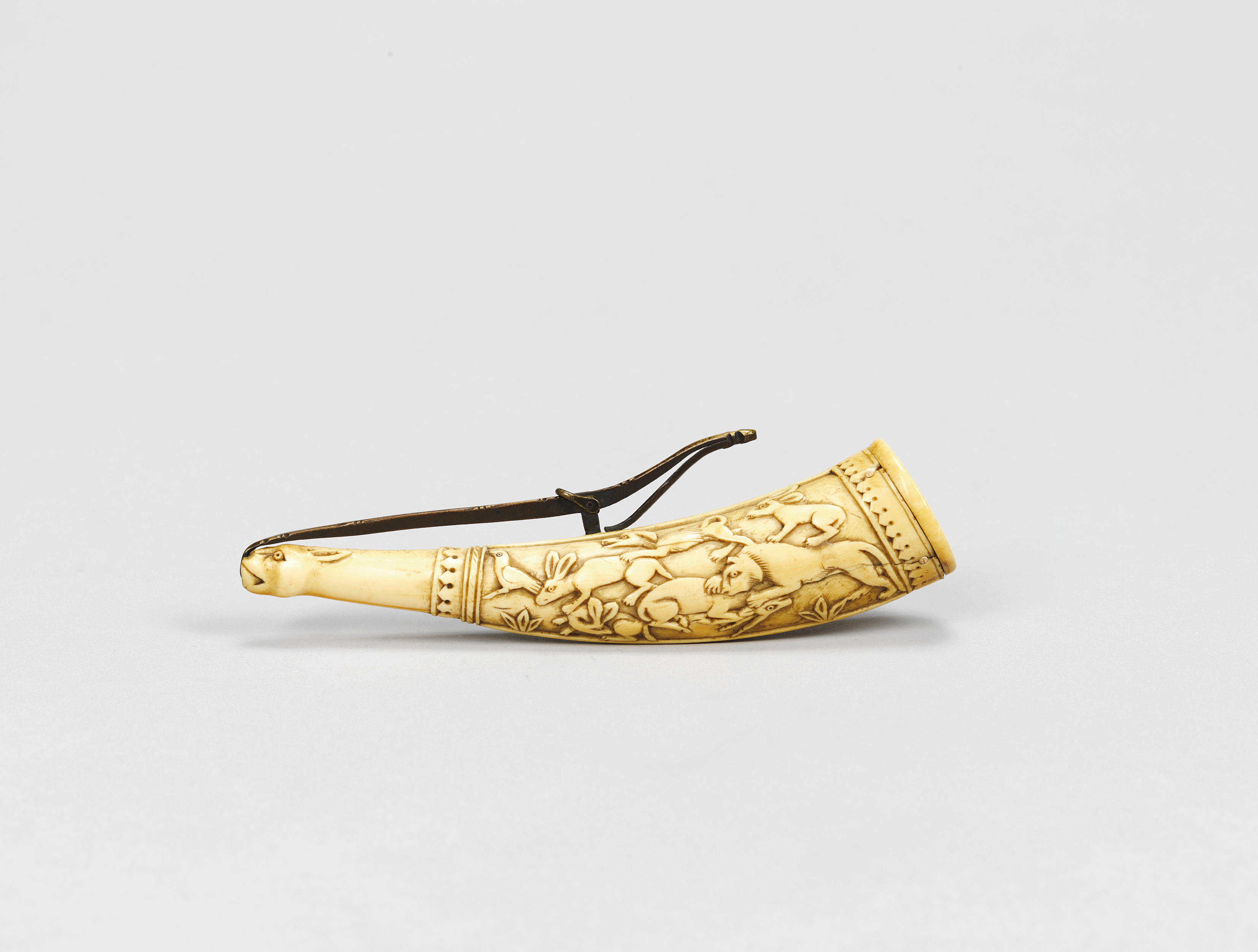Of gently curved form, one end in the form of a deer head, carved on either side with an animal hunting scene between crenellated border, one end with fitted lid now closed with pins, with brass mechanism to top to release the powder. 18.4 cm. CATALOGUE NOTE Powderhorns of this type were made to hold the fire powder used to prime the flash-pan and touchhole of a musket. Once ignited, the powder detonated the charge powder and caused the musket to fire. The charge powder was carried in a powder, whereas a small flask such as the present lot held the priming powder. This flask consists of an ivory container and an ivory lid. When filled with powder, the two parts were held together with pins. A metal lever is attached to the top of the primer: when pressed, this opened a hole at the end of the lid so that the priming powder could be poured into the musket. The metal ring at the centre of the lever was used to suspend the flask from a belt or sash. This powder flask belongs to a group of vessels of similar appearance and high quality, probably produced by a small number of workshops in 17th century Mughal India. Like others, it depicts animal scenes appropriate for an object associated with armed combat or hunting expeditions. They represent a distinctive group of Mughal ivory carvings that favour naturalism rather than stylization, and were inspired by miniature paintings and the fantastical animals that were a popular subject in imperial Mughal workshops. Other examples can be seen in the Virginia Museum of Fine Arts (Joseph M. Dye II, The Arts of India, Virginia, 2001, pp. 424-35, no. 200; the Nasser D Khalili Collection, London (David Alexander The Arts of War: Arms and Armour of the 7th to 19th Centuries, London, 1992, no. 115); the Furusiyya Art Foundation Collection (Bashir Mohamed, The Arts of the Muslim Knight. The Furusiyya Art Foundation, Milan, 2007, pp. 286-89, nos. 279-82; the Musee Guimee, Paris (George Michel, The Majesty of Mughal Decoration. The Art and Architecture of Islamic India, London, 2007, p. 257, no. 73); and the David Collection, Copenhagen (Kjeld von Folsach, Islamic Art from the David Collection, Copenhagen, 2001, p. 258, no. 414; and an example was sold through Bonhams, Islamic and Indian Art, 10th April 2008, lot 2008. Please note: this lot contains ivory and is therefore subject to the relevant trade restrictions in correspondence with CITES regulations. Customers should familiarize themselves with the relevant CITES regulations before bidding.
Of gently curved form, one end in the form of a deer head, carved on either side with an animal hunting scene between crenellated border, one end with fitted lid now closed with pins, with brass mechanism to top to release the powder. 18.4 cm. CATALOGUE NOTE Powderhorns of this type were made to hold the fire powder used to prime the flash-pan and touchhole of a musket. Once ignited, the powder detonated the charge powder and caused the musket to fire. The charge powder was carried in a powder, whereas a small flask such as the present lot held the priming powder. This flask consists of an ivory container and an ivory lid. When filled with powder, the two parts were held together with pins. A metal lever is attached to the top of the primer: when pressed, this opened a hole at the end of the lid so that the priming powder could be poured into the musket. The metal ring at the centre of the lever was used to suspend the flask from a belt or sash. This powder flask belongs to a group of vessels of similar appearance and high quality, probably produced by a small number of workshops in 17th century Mughal India. Like others, it depicts animal scenes appropriate for an object associated with armed combat or hunting expeditions. They represent a distinctive group of Mughal ivory carvings that favour naturalism rather than stylization, and were inspired by miniature paintings and the fantastical animals that were a popular subject in imperial Mughal workshops. Other examples can be seen in the Virginia Museum of Fine Arts (Joseph M. Dye II, The Arts of India, Virginia, 2001, pp. 424-35, no. 200; the Nasser D Khalili Collection, London (David Alexander The Arts of War: Arms and Armour of the 7th to 19th Centuries, London, 1992, no. 115); the Furusiyya Art Foundation Collection (Bashir Mohamed, The Arts of the Muslim Knight. The Furusiyya Art Foundation, Milan, 2007, pp. 286-89, nos. 279-82; the Musee Guimee, Paris (George Michel, The Majesty of Mughal Decoration. The Art and Architecture of Islamic India, London, 2007, p. 257, no. 73); and the David Collection, Copenhagen (Kjeld von Folsach, Islamic Art from the David Collection, Copenhagen, 2001, p. 258, no. 414; and an example was sold through Bonhams, Islamic and Indian Art, 10th April 2008, lot 2008. Please note: this lot contains ivory and is therefore subject to the relevant trade restrictions in correspondence with CITES regulations. Customers should familiarize themselves with the relevant CITES regulations before bidding.















Try LotSearch and its premium features for 7 days - without any costs!
Be notified automatically about new items in upcoming auctions.
Create an alert